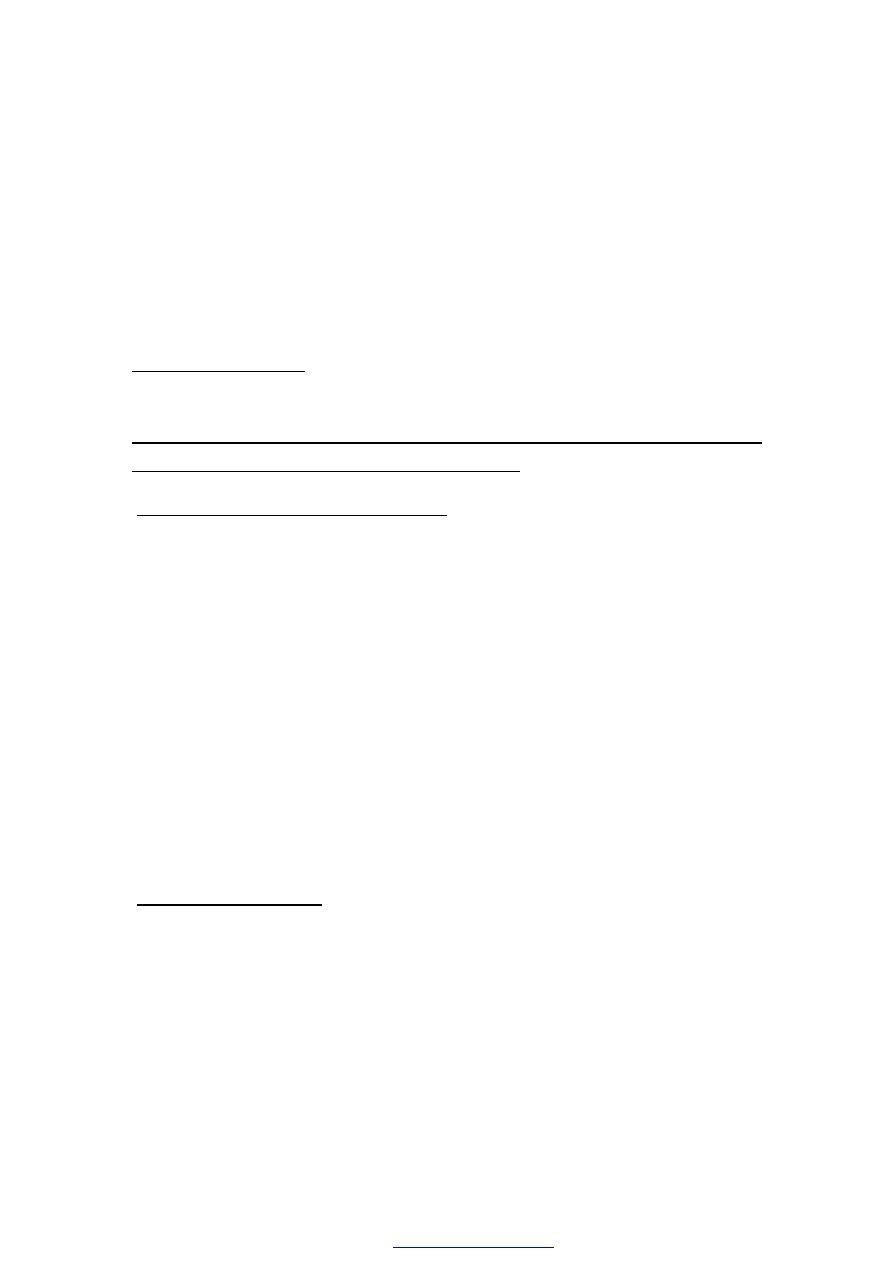
1
Occupational Health
By
Dr. Ashraf MA. Hussain
Msc. Community Medicine
Occupational Health: is a multidisciplinary activity, defined by I.L.O.
(International Labor Organization), as
the promotion and maintenance of highest degree of physical, mental and
social wellbeing of workers in all occupations.
Activities of Occupational Medicine :
1. Medical exam. Of the workers;
a. pre employment exam.
b. periodic exam.
2. Health educa on.
3. First –aid facilities.
4. Rehabilita on.
5. Epidemiological studies and medical records.
6. Environmental and biological monitoring.
Occupational Hygiene : The practice of identifying of hazardous agents;
chemical, physical and biological; in the workplace that could cause disease
or discomfort, evaluating the extent of the risk due to exposure to these
hazardous agents, and the control of those risks to prevent ill-health in the
long or short term.
PDF created with pdfFactory Pro trial version

2
The objectives are
1. protecting worker health and well-being
2. safeguarding the community at large
* Types of occupational hazards :
1. Physical hazards (noise, vibration, temperature, electricity, radiation,
light and pressure ).
2. Chemical hazards (dust, mists, fumes, gases, fibers, vapors and
liquids).
3. Biological hazards (insects, mites, moulds, yeasts, fungi, bacteria,
viruses and parasites) .
4. Ergonomic : fitness of the work process and work place to the
workers (posture, movement, repetitive motion and light) .
5. Psychological hazards (tension, stress, and phobia) .
6. Accidents and mechanical hazards .
Control of occupational hazards
}
Main Concepts:
1. Occupational hazards can be controlled by a variety of methods.
2. The goal of controlling a hazard is to prevent workers from being
exposed to the hazard.
3. The most effective control measure is to control hazards at the
source by eliminating the hazard or by substituting a hazardous
chemical, machine, work process, etc., with a less dangerous one.
4. It is important to recognize hazards and health and safety problems
in the workplace.
PDF created with pdfFactory Pro trial version

3
5. There are five general categories of control measures: elimination,
substitution, engineering controls, administrative controls and
personal protective equipment.
6. A combination of methods usually provides a safer and healthier
workplace than relying on only one method.
7. Personal protective equipment should be the last choice in control
measures.
1. Elimina on
}
Is the most effective method of control.
}
Elimination of a specific hazard or hazardous work process, or
preventing it from entering the workplace (Eliminate hazards at the
“development stage”)
}
It is important to consider worker health and safety when work
processes are still in the planning stages. For example, when
purchasing machines, safety should be the first concern, not cost.
}
Machines that are not produced with the proper guards on them
may cost less to purchase, but cost more in terms of accidents, loss
of production, compensation, etc.
}
Unfortunately, many used machines that do not meet safety
standards are exported to developing countries, causing workers to
pay the price with accidents, hearing loss from noise, etc.
2. Subs tu on
}
If a particularly dangerous chemical or work process cannot be
completely eliminated, then try to replace it with a safer substitute
}
These materials can be more expensive to purchase but they are
safer for workers to handle and can be cheaper when other costs are
PDF created with pdfFactory Pro trial version

4
considered, such as the cost of ventilation to control dust, personal
protective equipment,
}
less volatile (volatile liquids vaporize, or evaporate easily) instead of
a highly volatile one
}
many dry, dusty powders are also available in brick, pellet, paste,
flakes, oil damped powders, and other forms that create less dust
when handled, and reduce the chance of inhaling the dust.
}
detergent plus water-cleaning solutions instead of organic solvents
}
leadless glazes in the ceramics industry leadless pigments in paints
}
synthetic grinding wheels (such as aluminium oxide, silicon carbide)
instead of sandstone wheels
}
vacuum cleaner when cleaning up toxic dust. Never sweep toxic
dust with brooms or brushes
3. Engineering controls
These include enclosure, isolation and ventilation.
a. Enclosure
}
If a hazardous substance or work process cannot be eliminated or
substituted, then enclosing it so workers are not exposed to the
hazard is the next best method of control.
}
Many hazards can be controlled by partially or totally enclosing the
work process.
}
Highly toxic materials that can be released into the air should be
totally enclosed, usually by using a mechanical handling device or a
closed glove system that can be operated from the outside
}
Whole areas of a plant can be “enclosed” by requiring workers to
operate those areas from a control room.
PDF created with pdfFactory Pro trial version

5
}
Machine guarding is another form of enclosure that prevents
workers from coming into contact with dangerous parts of machines.
}
Some of the areas of a machine that can injure the worker are: the
point of operation pinch-points; sharp areas, such as blades; exposed
electrical components, which can cause electrical shock or burns;
presses, which can crush; rotating parts; flying chips and sparks.
b. Isolation
}
Isolation can be an effective method of control if a hazardous job can
be moved to a part of the workplace where fewer people will be
exposed,
}
or if a job can be changed to a shift when fewer people are exposed
(such as a weekend or midnight shift).
}
The worker can also be isolated from a hazardous job, for example
by working in an air-conditioned control booth.
}
isolating the work process or the worker does not eliminate the
hazard, which means workers can still be exposed
c. Ventilation
}
Ventilation in the workplace can be used for two reasons:
}
(1) to prevent the work environment from being too hot, cold, dry or
humid;
}
(2) to prevent contaminants in the air from ge ng into the area
where workers breathe.
PDF created with pdfFactory Pro trial version

6
Generally there are two categories of ventilation:
1. local exhaust ventilation
2. general ventilation.
Ventilation should be used together with other methods of control.
Local exhaust ventilation
}
It usually uses suction, based on the principle of a vacuum cleaner, to
remove pollutants from the air.
}
Exhaust ventilation can include the use of flexible piping.
}
The end of the pipe that draws in the contaminants (the inlet) must
be placed as close as possible to the source of the hazard in order to
be effective.
}
Flexible piping is often used to draw welding fumes away from the
worker and to draw away contaminants in work areas that are hard
to reach.
}
General ventilation
}
Which is generally used for keeping the workplace comfortable.
}
It is one of the least effective methods of controlling hazards but one
of the most commonly used.
}
The purpose of any general ventilation system is to remove
contaminated air and replace it with “fresh” air.
}
This system does not really remove hazardous agents from the air; it
simply reduces the amounts in the air to levels that are considered
“safe” for breathing.
PDF created with pdfFactory Pro trial version

7
The effectiveness of a general ventilation system depends on several
things, including:
}
how quickly the hazardous agent is being released into the air;
}
how much and how quickly fresh air is coming in;
}
and how the contaminated air is being removed.
4. Administra ve controls
}
Limiting the amount of time workers spend at a hazardous job.
}
Used together with other methods of control to reduce exposure to
hazards. Some examples of administrative controls include:
}
changing work schedules (for example, two people may be able to
work for four hours each at a job instead of one person working for
eight hours at that job);
}
giving workers longer rest periods or shorter work shifts to reduce
exposure time;
}
moving a hazardous work process to an area where fewer people will
be exposed;
}
changing a work process to a shift when fewer people are working.
}
Administrative controls only reduce the amount of time workers are
exposed to a hazard but do not eliminate exposures.
5. Personal protec ve equipment
}
Personal protective equipment (PPE) is the least effective method of
controlling occupational hazards and should be used only when other
methods cannot control hazards sufficiently.
}
PPE can be uncomfortable, can decrease work performance and can
create new health and safety hazards.
PDF created with pdfFactory Pro trial version

8
}
For example, ear protectors can prevent the worker from hearing
warning signals, respirators can make it harder to breathe, earplugs
may cause infection, and leaky gloves can trap hazardous chemicals
against the skin.
}
Hot or humid working conditions decrease the effectiveness of PPE.
Under these conditions, workers should take frequent breaks and
drink plenty of fluids.
}
The type of PPE required depends on the hazard, the way exposure
affects the body and the exposure time.
}
If PPE does not fit well it may not protect the worker; this is
particularly important with respirators.
}
All PPE should be checked for leaks.
}
All workers using PPE should be trained in the proper use,
maintenance and limitations of PPE.
6. Other methods of control
a. General cleanliness
}
Keeping a clean and organized workplace is an important method of
controlling hazards.
}
Good housekeeping (keeping a clean workplace) reduces the risk of
fire and is cost-effective, since machines and tools that are cleaned
regularly need less servicing.
}
At the same time, maintaining a pleasant working environment can
produce higher productivity
PDF created with pdfFactory Pro trial version

9
Good work practices include:
1. proper cleaning at regular intervals (using industrial vacuum cleaner)
2. proper waste disposal
3. proper and immediate clean-up of any spills
4. correct storage and labeling of materials.
b. Personal cleanliness
}
Finally, personal hygiene (cleanliness) is also very important as a
method of controlling hazards.
}
Employer should provide facilities so worker can wash and/or take a
shower every day at the end of working shift
}
Worker should wash skin and hair with a mild soap, rinse and dry skin
completely to protect it.
}
Washing hands regularly
}
Eating and smoking away from the work area help to prevent
ingesting contaminants.
}
Worker should leave dirty clothes at work and if necessary, washing
work clothes done separately not with the family wash.
}
So Worker does not take workplace hazards home with him.
C. first-aid facility
}
Every workplace should have some kind of first-aid facility
}
Every workplace should have as well adequate personnel trained to
provide first aid.
}
First-aid facilities and trained personnel are important components
of a healthy and safe workplace.
PDF created with pdfFactory Pro trial version

10
* General control measures of occupational hazards :
1. Elimination &/or substitution (most effective but most difficult)
}
( substitute injections by administrating medication through another
route
}
(Usage of unleaded gasoline)
}
Replace flooring with more slip-resistant surface
2. Isolation of the process . As in x ray room
3. Total enclosure of the process.
4. Shielding of the source or worker.
5. Suppression of the emission .
6. Locally applied exhausted ventilation.
7. General ventilation .
6. Reduce time of exposure (Work shift )
7. Health education to the workers (information, training and
instruction) .
8. Personal protective equipment.
9. General cleanliness .
10. Personal hygiene .
and
PDF created with pdfFactory Pro trial version

11
11. Maintaining control by:
a. pre employment exam
}
Provide a baseline data for further compare and assessment.
}
to ensure that prospective employees can perform their jobs safely
and effectively.
}
No further deterioration of the health status of the employee.
}
Adapt the work according to the capabilities of the worker.
b. periodic medical exam
1. Routine medical examination.
2. After long absence medical examination.
3. After any change in the process or the substances used at the work
c. monitoring procedures .
GOOD LUCK
PDF created with pdfFactory Pro trial version
